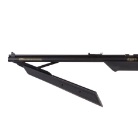In case you didn’t know, airguns shoot by taking compressed air that’s released, pushing a projectile down a barrel. Some of the oldest airguns used springs with pistons to make this happen. An on-board pump was fitted to an airgun, and pump pneumatic airguns were born.
Whether single pump or multi-pump, pump pneumatic airguns are some of the most popular airguns sold in the USA. Let’s take a look at why they are still a great option, especially for new airgunners.
Easy Accuracy
The Daisy 953 is a single pump pneumatic airgun that was the starting point for many competitive 10 meter shooters. With a single pump, you could get about 500 FPS with zero recoil and great accuracy. Adding diopter sights simulates what these shooters will use as they move up in the sport, maybe to the Olympics.
Very Affordable & Fun to Shoot
As with all airgun variants, there are entry-level options all the way up to boutique airguns costing much more. Even “expensive” pump rifles and pistols are very affordable compared to other airgun types on the market. They are also pretty easy to shoot, being lightweight and having virtually no recoil.
These airguns are ideal for younger shooters just starting. They deliver less power, which may be essential when teaching new shooters gun safety and proper shooting techniques.
Single vs Multi-Pump
There are two classes of pump pneumatic airguns; multi-pump and single pump. As stated earlier in this article, airguns work by taking compressed air and using it to force a projectile down the barrel.
A single pump pneumatic has a reservoir that’s pressurized with a single pump of the pump handle. The aforementioned Daisy 953 is an example of a single pump pneumatic airgun. Cocking the bolt forces the hammer against the hammer spring. The hammer is held by the sear, which is released and strikes the valve, sending the pressurized air through the transfer port and out the barrel when the shooter squeezes the trigger. Unlike a spring airgun, there’s no heavy piston or massive spring to disrupt the shooting cycle.
A multi-pump pneumatic works much the same, but shooters need to use multiple pumps to pressurize the air reservoir rather than a single stroke. While you don’t get max power with just one pump, there’s an advantage as you can vary the power output by reducing or increasing the number of pumps. So for just plinking practice, you may only need 3 or 4 strokes. But if you need to use your gun for longer range shots or pesting, you can go to the maximum number of pumps, (check the manual on your airgun for the max number of pumps) to get the most power.
Hunting with Pump Pneumatic Airguns
Most of the airguns we’ve talked about so far have been for close-range target practice, youth airguns, and plinking and very light pesting. But there are some pump pneumatics that raise the bar and are great options for serious target practice and small game hunting.
The most popular hunting multi-pump is perhaps the Benjamin 392 or 397, now sold as the Benjamin Variable Pump. This is an adult-sized airgun that packs a serious punch, generating up to 800 FPS in .22 caliber at max power. With zero recoil, shooters can shoot the Benjamin Variable Pump much like they would a typical .22LR. Many shooters love this airgun for its power and how easy it is to achieve accuracy at longer ranges. It’s a great throwback to the good ol’ days of airgunning.
The newest take on the pump pneumatic train is the Seneca Aspen. Where the traditional multi-pump will dump the entire reservoir for each shot, forcing the shooter to pump back up for each subsequent shot, the Aspen combines the benefits of an on-board hand pump with the power and multi-shot capabilities of a PCP. All the pumps are put in ahead of time, up to 80 for a full charge, delivering dozens of shots per full fill when shooting on low power. The Aspen is a fully self-contained PCP generating more than twice the power of a typical pump-pneumatic. It’s also magazine-fed giving shooters quick follow-up shots when needed.
We have certainly come a long way in the world of pump pneumatic airguns! Are you looking for the best pump pneumatic airgun for your needs? Then give us a call, and we’ll help you find the perfect fit!
